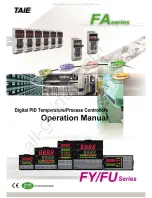
Solar Charge Controllers
Steca Elektronik GmbH | 87700 Memmingen | Germany | Fon +49 (0) 8331 8558-0 | Fax +49 (0) 8331 8558-132 | www.steca.com
128
187
49
85
177
20
5
4x ø5
Steca Solarix
2401, 4401
The solar charge controllers Steca Solarix 2401 and 4401 are
optimally suited for inverter systems. The controller combines
basic solar charger functions with a 40 A high-performance
charge controller. It is available as 12 V / 24 V and 48 V system.
This makes the solar charge controller very cost effective.
The load current is limited to 10 A. The charging processes
are based on the voltage level, which can be individually set
with the help of four buttons behind the front casing.
Product features
Hybrid controller
Voltage regulation
Automatic detection of voltage
PWM control
Multistage charging technology
Load disconnection depending on voltage
Automatic load reconnection
Temperature compensation
Common positive grounding or negative grounding on
one terminal
Integrated self test
Monthly maintenance charge
Electronic protection functions
Overcharge protection
Deep discharge protection
Reverse polarity protection of load, module and battery
Reverse polarity protection by internal fuse
Automatic electronic fuse
Short circuit protection of load and module
Overvoltage protection at module input
Open circuit protection without battery
Reverse current protection at night
Overtemperature and overload protection
Battery overvoltage shutdown
Displays
Text LCD display
—
for operating parameters, fault messages, self test
Operation
Simple menu-driven operation
Programming by buttons
Manual load switch
Interfaces
RJ45 interface
Options
External temperature sensor
Alarm contact
Certificates
Compliant with European Standards (CE)
Made in Germany
Developed in Germany
Manufactured according to ISO 9001 and ISO 14001
[40 A]
[areas of application]
1920 W
2401
4401
Characterisation of the operating performance
System voltage
12 V (24 V)
48 V
Own consumption
14 mA
DC input side
Module current
40 A
DC output side
Load current
10 A
End of charge voltage
13.7 V (27.4 V)
54.8 V
Boost charge voltage
14.4 V (28.8 V)
57.6 V
Equalisation charge
14.7 V (29.4 V)
58.8 V
Reconnection voltage (LVR)
12.6 V (25.2 V)
50.4 V
Deep discharge protection (LVD)
11.1 V (22.2 V)
44.4 V
Operating conditions
Ambient temperature
-10 °C … +60 °C
Fitting and construction
Terminal (fine / single wire)
16 mm
2
/ 25 mm
2
- AWG 6 / 4
Degree of protection
IP 32
Dimensions (X x Y x Z)
187 x 128 x 49 mm
Weight
550 g
Technical data at 25 °C / 77 °F
programmable
Steca PA TSK10
External temperature sensor

































